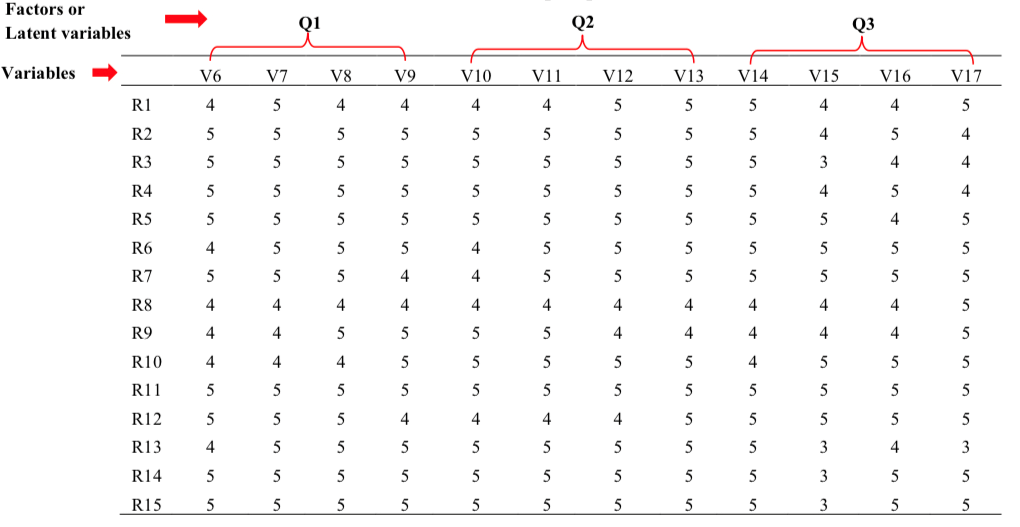Summary
Extraction of latent variables (factors) from a dataset can be done in several ways. This essay uses a principal components analysis of variances will be used (Watkins, 2018). This method posits that the variances equal the eigenvalue. The eigenvalue size is used to determine the number of factors (Watkins, 2018). The ones with relatively large eigenvalues are picked while the others are discarded to identify the relevant factors. The Kaiser approach was used to select only factors with eigenvalues greater than 1. Three latent variables were determined from the process, and they include Q1, Q2, and Q3.

Table 2: Names of Extracted Latent Variables
Interpretation
For the above factors to be selected, they have to meet the following requirements:
- They must have a Kaiser-Meyer-Olkin (KMO) test score ranging from 0.6 to 1.0.
- The factor loading must be greater than 0.50.
- Bartlett’s significance must be less than 5%.
- The cumulative eigenvalues must be greater than 50%
The KMO test is a measure of how relevant the data is for factor analysis. It measures the proportion of variance among variables that can be common variance (Watkins, 2018). A lower proportion depicts that the data is more usable in the factor analysis. KMO test values range from 0 to 1, with 0.8 to 1 representing more appropriate data for factor analysis. In contrast, values near 0 depict significant partial correlations relative to correlations, and hence the values are unacceptable in the analysis. Factor loading is a matrix that shows the relationship of each variable to the underlying factor. It indicates the correlation coefficient for observed variables and factors (Watkins, 2018). A higher factor loading means that the factor extracted much variance from the variable or question.
Efficiency
Efficiency, in this case, is a name given to the latent variable Q1 associated with V6 to V9. It covers aspects of the time spent by customers waiting to be served and the willingness to serve the customers. It also relates to the speed with which the clients were attended to by the Citizen Services Center’s (CSC) staff and the workers’ politeness to the customers. From Table 2, it can be observed that the majority of the responses were 4 or 5, where 4 stands for ‘Satisfied’ while 5 means ‘Very satisfied’.
Table 3: KMO and Bartlett’s Test for Efficiency
Table 4: Factor Loading for Efficiency
Customer Relation and Service
The customer service factor associates with variables V10 to V13. It assesses customer satisfaction on factors such as the effort made by the CSC workers to comprehend client requests and the customers’ level of understanding of the employees’ information. It also refers to whether the services matched with and met the customers’ needs. From Table 2, most respondents were either satisfied or very satisfied with the service and how it was delivered.
Table 5: KMO and Bartlett’s Test for Customer Relation and Service
Table 6: Factor Loading for Customer Relation and Service
Accessibility
The accessibility factor combines the variables V14 to V17 since they are related. It is related to aspects such as the accessibility of the reference CSC from the client’s home or workplace, insights into the CSC ambiance, and opening hours, among other factors. From the survey answers, it has been noted that most people were either satisfied or very satisfied based on the questions asked in the questionnaire.
Table 7: KMO and Bartlett’s Test for Accessibility
Table 8: Factor Loading for Accessibility
The Bartlett’s Test of Sphericity which tests for the hypothesis of non-correlation, has proved that the test is significant, showing that the correlation matrix is not an identity matrix. It can be observed that Bartlett’s significance value is 0.00, which meets the condition that the value should not go beyond 5 % (0.05).
Furthermore, each of the factor’s KMO scores indicate that each of them is significant in determining customer satisfaction. Efficiency’s KMO value is 0.814 while that of customer relation and service is 0.831, and accessibility’s KMO value has been evaluated as 0.774. Since a KMO score of 0.6 and above indicates that the factor is suited for factor analysis, the three-factor are suitable for measuring customer satisfaction.
The factor loadings for efficiency (0.953, 0.944, 0.974, 0.950), customer relation and service (0.921, 0.955, 0.991, 0.989), and accessibility (0.937, 0.923, 0.964, 0.978) are all above 0.5. From the values, it is clear that the questions had a high correlation. Initially, this paper stated that factor loading of 0.5 and above would mean that a factor is important in customer satisfaction. Therefore, all three factors are significant when determining levels of customer satisfaction.
References
Watkins, M. W. (2018). Exploratory factor analysis: A guide to best practice.Journal of Black Psychology, 44(3), 219-246.